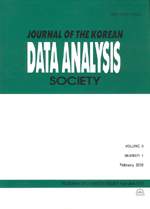보험회사의 수익구조에 따른 차별적 이익품질에 관한 연구
A Study on the Differential Earnings Quality based on the Profit Structure of Insurance Companies
- 한국자료분석학회
- Journal of The Korean Data Analysis Society (JKDAS)
- Vol.24 No.2
-
2022.04765 - 778 (14 pages)
-
DOI : 10.37727/jkdas.2022.24.2.765
- 이용수 88

초록
본 논문에서는 보험회사의 회계이익 품질이 보험회사의 수익구조에 따라 달라지는지 여부에 대하여 연구하였다. 회계이익의 품질은 회계이익의 지속성과 가치관련성으로 나누어 분석하였고, 보험회사의 수익구조는 보험손익과 투자손익의 상대적인 비중으로 측정하였다. 연구표본으로는 국내 상장 보험회사의 국제회계기준 도입이후의 표본인 2011년부터 2021년까지의 분기별 표본을 이용하였다. 연구결과, 보험손익의 상대적인 비중이 높아질수록 회계이익의 지속성과 가치관련성이 모두 높게 나타났다. 이러한 결과는 지속성이 높은 이익이 높은 가치관련성을 가진다는 선행연구의 결과와 일관된 것이다. 그러나 회계이익의 지속성에 대한 선행연구에서의 주된 논의는 현금흐름과 발생액의 구성에 대한 것이었으나 본 논문에서는 보험회사의 주된 영업활동이 보험영업과 투자영업으로 이루어진다는 점에 착안하여, 두 가지 영업활동 성과의 구성을 기준으로 회계이익의 지속성이 차별화되고, 차별화된 이익지속이 가치관련성의 차이를 유발하게 된다는 점을 밝혔다는 점에서 의의를 가진다.
This paper studied whether the earnings quality of insurance companies varies depending on the profit structure of the insurance company. The earnings quality was analyzed by dividing it into the relationship between persistence and value relevance of earnings, and the profit structure of insurance companies was measured as the relative proportion of insurance and investment gains and losses. As a study sample, quarterly samples from 2011 to 2021, which are samples after the adoption of IFRS by domestic listed insurance companies, were used. As a result of a study on the earnings persistence of insurance companies, the higher the relative proportion of insurance gains and losses, the higher the persistence and value relevance of earnings. These results are consistent with the results of previous studies that high persistent earnings have high value relevance. The main discussion in previous studies on the earnings persistence was the composition of cash flows and accruals. However, this paper is significant in that it revealed that earnings persistence is differentiated based on the composition of the two business activities, and differentiated earnings persistence causes differences in value relevance of earnings.
목차
1. 서론
2. 이론적 배경 및 가설설정
3. 연구모형 설계
4. 분석결과
5. 요약 및 결론
References
참고문헌 (0)
등록된 참고문헌 정보가 없습니다.
해당 권호 수록 논문 (31)
- 잠재토픽모형을 이용한 이미지 군집화에 대한 연구
- Dimension Reduction and Classification with Weighted Supervised PCA
- 시간 제약 제시 방식이 과제 수행에 미치는 영향
- 공변량의 측정오차를 고려한 로그 변환된 소지역 모델의 계층적 베이즈 추정
- 소비자중심적 경영활동이 기업의 재무성과 및 ESG에 미치는 영향
- GOP모형을 이용한 섹터지수 포트폴리오의 성과분석
- 겨울철 일 단위 노면온도 패턴에 대한 군집분석
- Financial Crisis and the Payout Policy under Asymmetric Information
- 불균형 시계열 자료를 위한 분류 알고리즘 적용방안
- Journal of The Korean Data Analysis Society Vol.24 No.2 목차
- A Research on Corporate Governance, Capital Structure, Default Risk, and Performance
- 비만 분류를 위한 인체 변수 선택 및 분류 방법에 대한 연구
- 공공기관의 부채비율 결정요인
- 다섯수치요약 정보에 근거한 정규모집단의 모수 추정에 관한 연구
- 4대 공적연금 가입 여성의 연령별 출산율 자료구축
- 경제분야 유튜브 인기 동영상의 대본과 댓글 연결망 비교 분석
- GARCH류 모형을 활용한 비트코인의 가격변화 특성에 관한 연구
- COVID-19의 치사율에 대한 사회·경제적 요인 및 이동성 결정요인 분석
- 시가변적 모수의 동태적 요인 모형을 이용한 아시아 지역의 경기 동조성에 관한 연구
- G시 공무원의 치매인식과 치매두려움이 치매태도에 미치는 영향
- 십분위분배율을 이용한 검벨분포의 적합도 검정
- VARX 모형을 활용한 제주 지역 가계부채 관련 정책의 실물경제 효과 분석 및 예측*
- 농촌태양광 이슈에 대한 소셜미디어 게시글과 이용자 댓글 분석
- 보험회사의 수익구조에 따른 차별적 이익품질에 관한 연구
- 에너지 소비와 경제성장의 동태적 관계에 관한 분석
- 동서양 문화권에서 정서 자극의 각성 수준이 정서가 평가에 미치는 영향
- 청탁금지법 시행이 경조비 지출에 미친 효과에 관한 실증분석
- 내부 기업지배구조가 경영성과와 기업가치에 미치는 효과
- QA 신경망 모델을 이용한 영미 시 감정 분류
- 자동차 산업의 대·중소기업 간 임금격차 해소방안에 관한 연구
- 분수 다항식 모형을 이용한 최저임금 변화의 창업에 대한 효과 분석